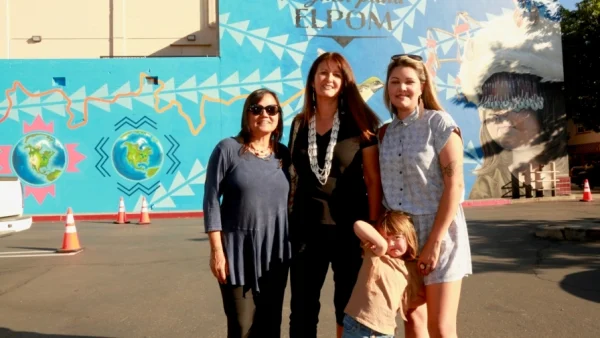By Marc T Dadigan
The July 7 official dedication of the mural in the adjacent US Bank parking lot was a momentous occasion for Wintu and other Native people, who often experience marginalization and invisibility in Redding, even thought it has been their homelands for thousands of years.
“I hope when people see the mural in such a prominent place that everyone feels the pride of being Indigenous and that it brings smiles to everyone’s faces,” said Michelle Radcliff-Garcia, a member of the Wintu Tribe of Northern California.
Radcliff-Garcia spoke in front of more than 65 people who had gathered Thursday to celebrate the completion of the $30,000 mural. The public art project was funded mostly through grants and was the culmination of more than five years of organizing work by a coalition of Native activists and community supporters.
Radcliff-Garcia developed the design of the mural with her daughter Vanessa Scholfield. The actual painting of the mural took only two weeks and was overseen by Carl Avery, a Yurok master muralist.
The mural features a hummingbird, a winged relative known for their healing abilities in Wintu culture, set against a cerulean blue background with radiating Wintu basket designs. The hummingbird hovers in front of the face of a 4-year-old Wintu girl, who’s wearing a headpiece used for ceremonial dancing regalia. The hummingbird’s flight path is traced by a sinuous, flame-toned line, representing Wintu people’s ancestors and how “they’re alway watching over us and guiding us,” Radcliff-Garcia said at the event.


At the top of the mural are the words “Wayken-pana El Pom”; Wintu words which loosely translate to “everyone is welcome in Redding.” El Pom refers to the band of Wintu whose territory includes the city.
Last Thursday at the dedication, many marveled at the striking beauty of the mural.
“I like the hummingbird. It looks so beautiful. It’s exciting for Wintu people because we’re going to get noticed,” said 9-year-old Joshua Garcia (Aztec/Wintu), who lives in Anderson.
Several at the event said they or relatives had already driven from outer areas of the county to view the art after seeing social media posts documenting its progress.
In the far corner of the mural are two planet Earths, one surrounded by red flames and the other by wavy blue lines. Vanessa Scholfield, who co-designed the mural, explained that the two globes represent Wintu people’s creation story, in which an animal relative first brought fire, spreading flames far across the world, and then another brought water, leading to great floods.
The creation story is about transformation, regeneration and rebirth, Scholfield said, explaining how a Wintu child is depicted in the mural to represent the importance of passing down their people’s culture to young and future generations.
“Culture is the cure for many of the mental health issues we have in our community,” Scholfield elaborated, adding she hopes the mural is a reminder to “listen to a story, sing a song, learn about plants, talk to an elder, that’s healing for you. If you give that to someone else, it’s healing for them.”
Research by Indigenous organizations and scholars indicate that public art like the Wintu mural in Redding are part of promoting respect and a deeper appreciation for Indigenous peoples. The Reclaiming Native Truth study, conducted by the non-profit organization Illuminative, found that most Americans have inaccurate misconceptions about Indigenous people, including beliefs in stereotypes about mystical noble savages or poverty-stricken reservations. But their research also showed that most people they surveyed want to learn more accurate information Indigenous histories and cultures. Exposure to Indigenous art can not only increase regular Americans’ understanding of Indigenous people, but also increase support for Indigenous causes, according to the study.
Public art projects such as the Wintu mural can also have a profound impact on Indigenous peoples themselves. Pit River Tribal Citizen Radley Davis said he interpreted the mural to depict how the connection to traditions and guidance from the ancestors can transform the world for the better: in a word, the mural symbolizes hope.
“This is a permanent piece of work, it’s not temporary. It’s a sign and symbol of all the work people have been doing for so many years to make this a better place,” he said. “To me, this means don’t give up. We can work together.”
The mural’s funding, design, and creation is the result of dogged organizing, grant writing and advocacy by a small collective of Native community members and allies. The group coalesced in 2017 as fellow participants in public meetings for the newly established Redding Cultural District and the last Redding Downtown Specific Plan update.
They began by successfully lobbying the city to include a respectful account of Wintu people’s history in the Downtown Specific Plan’s section about Redding’s past. Then, when an opportunity arose with the Cascade Theatre, the group began focusing on developing a Native-themed mural, said Miki’ala Catalfano, a Native Hawaiian and Shasta County resident.
Catalfano, the co-director of Native Roots Network, said she was inspired to support the mural project because her relatives have always told her to “tell our story” whether through meetings, school, relationships or art.
“I’m not in my homeland, but it’s still my responsibility to tell our story where I am and honor the people who are Indigenous to this place,” she said.


Marc Dadigan is Shasta Scout’s Associate Editor and Community Reporting covering Indigenous Affairs and the Environment. His writing has been published in Reveal, Yes! Magazine, the Christian Science Monitor, High Country News, and Indian Country Today. He welcomes your emails at [email protected].
Do you have a correction or other feedback? Email us at [email protected] or join the community conversation at Shasta Scout’s Facebook page.
TELL YOUR FRIENDS ABOUT CITIZENS JOURNAL Help keep us publishing –PLEASE DONATE



